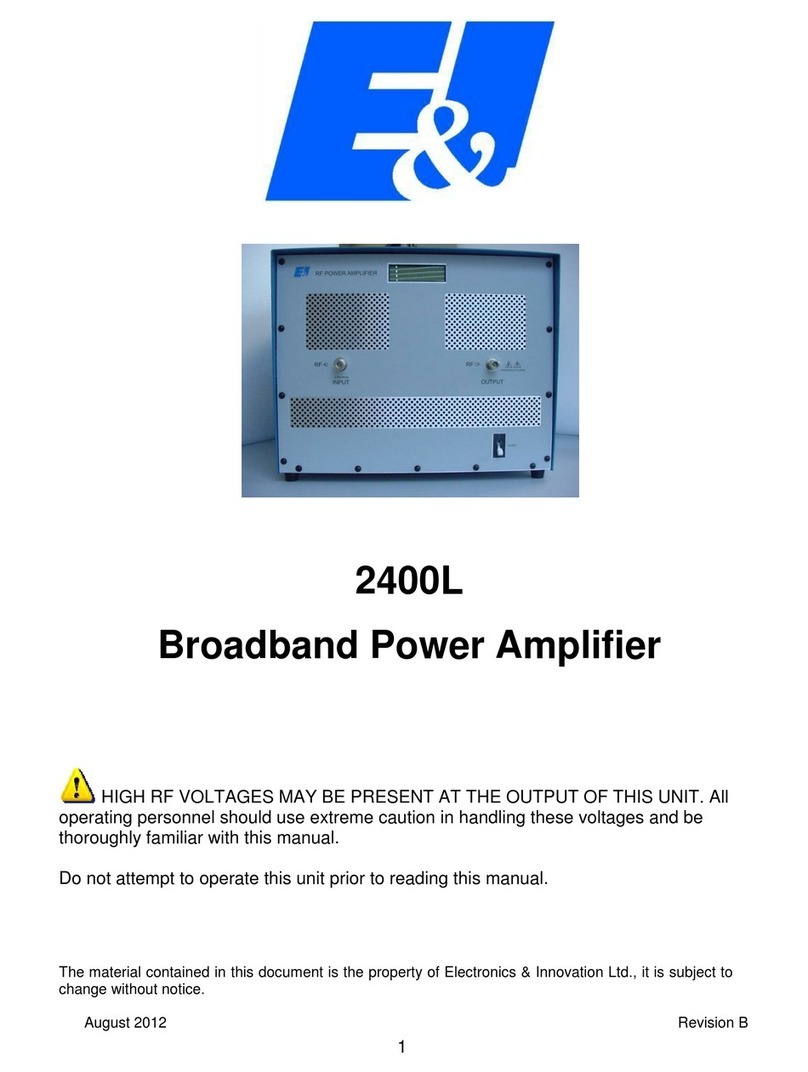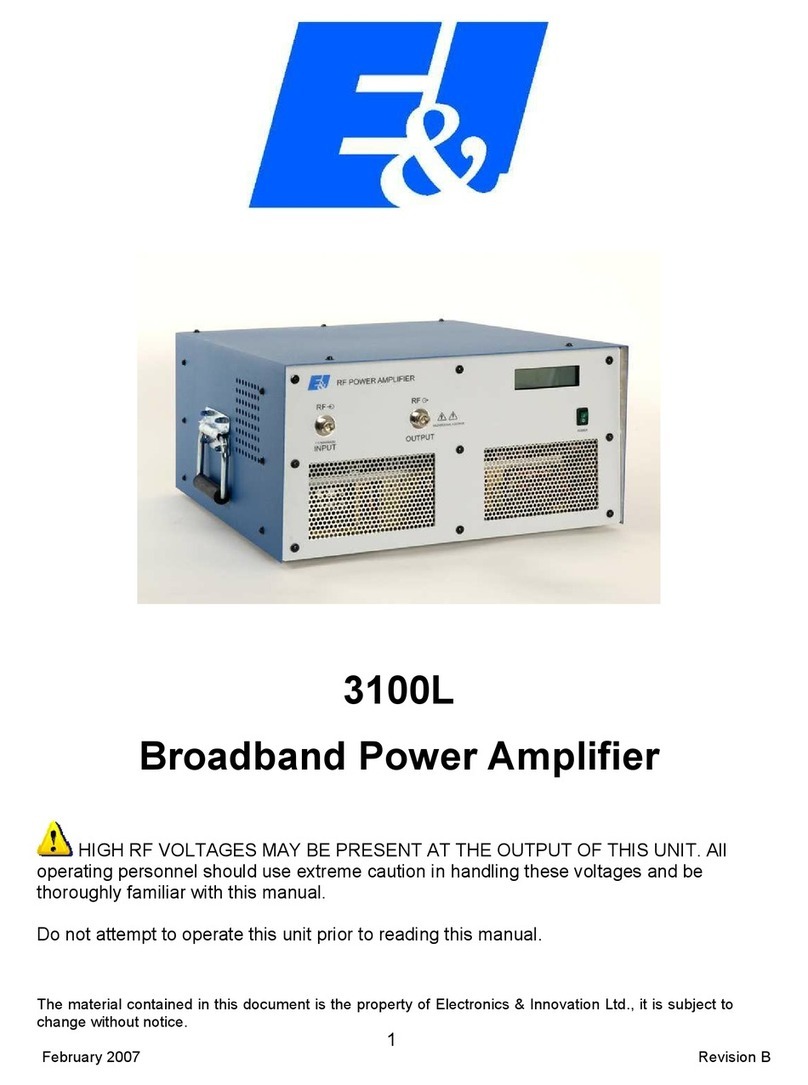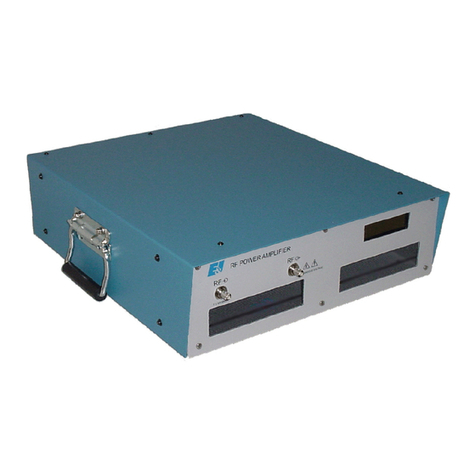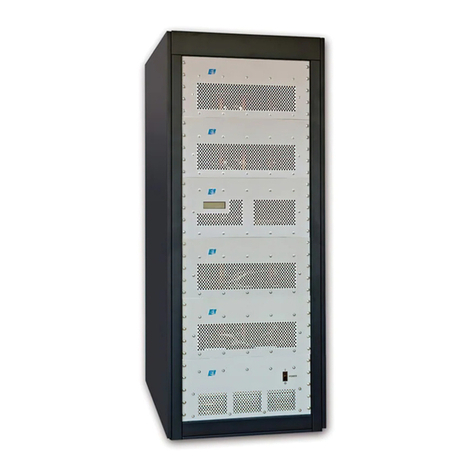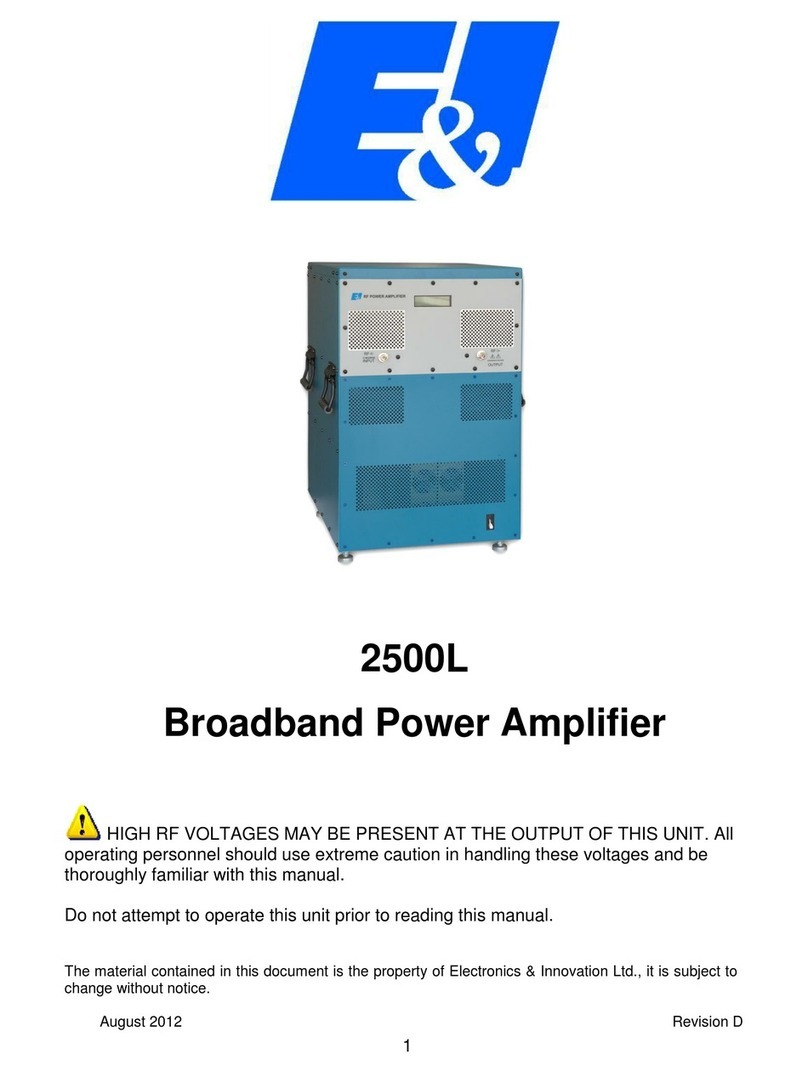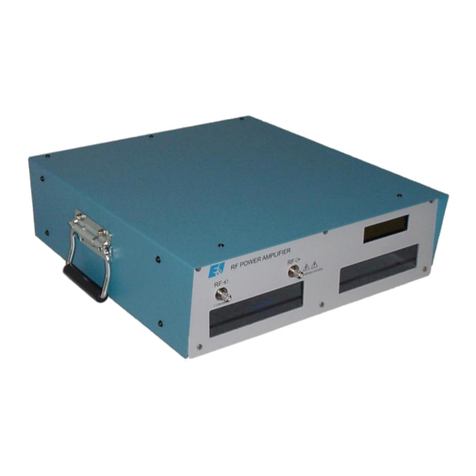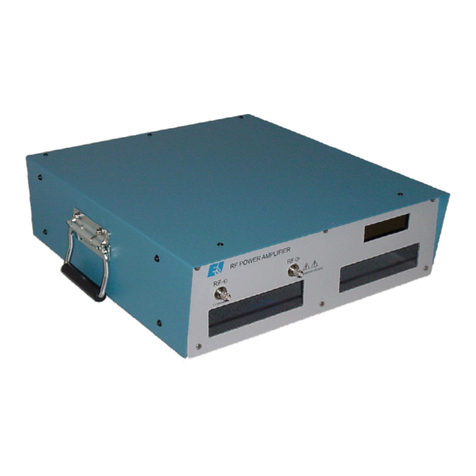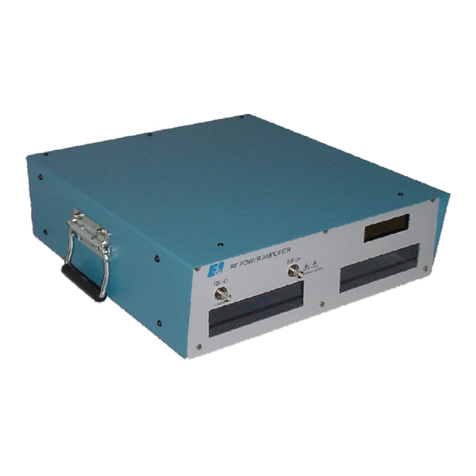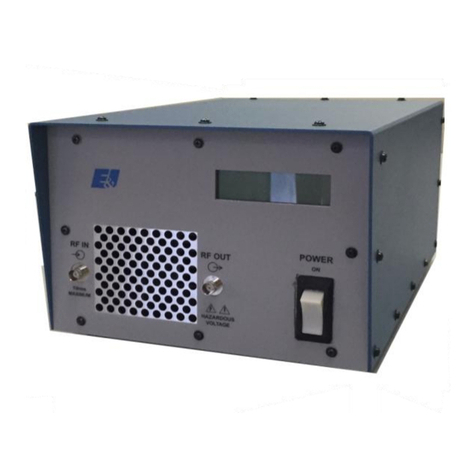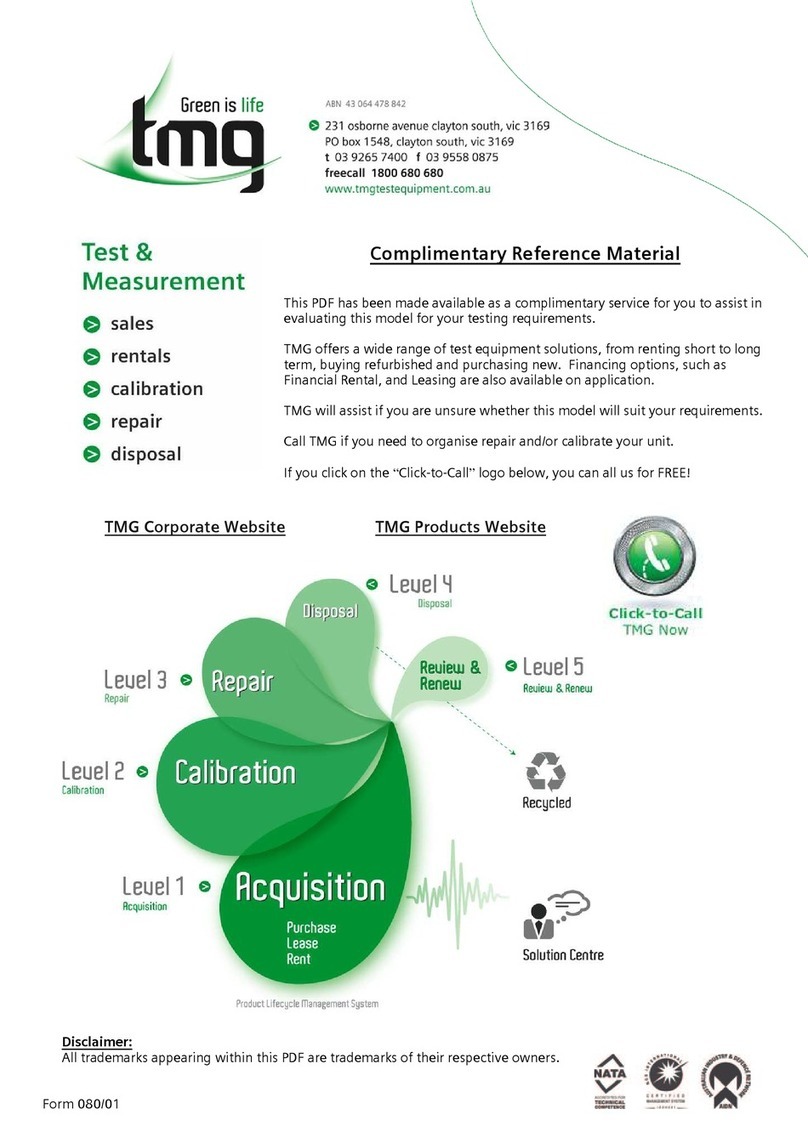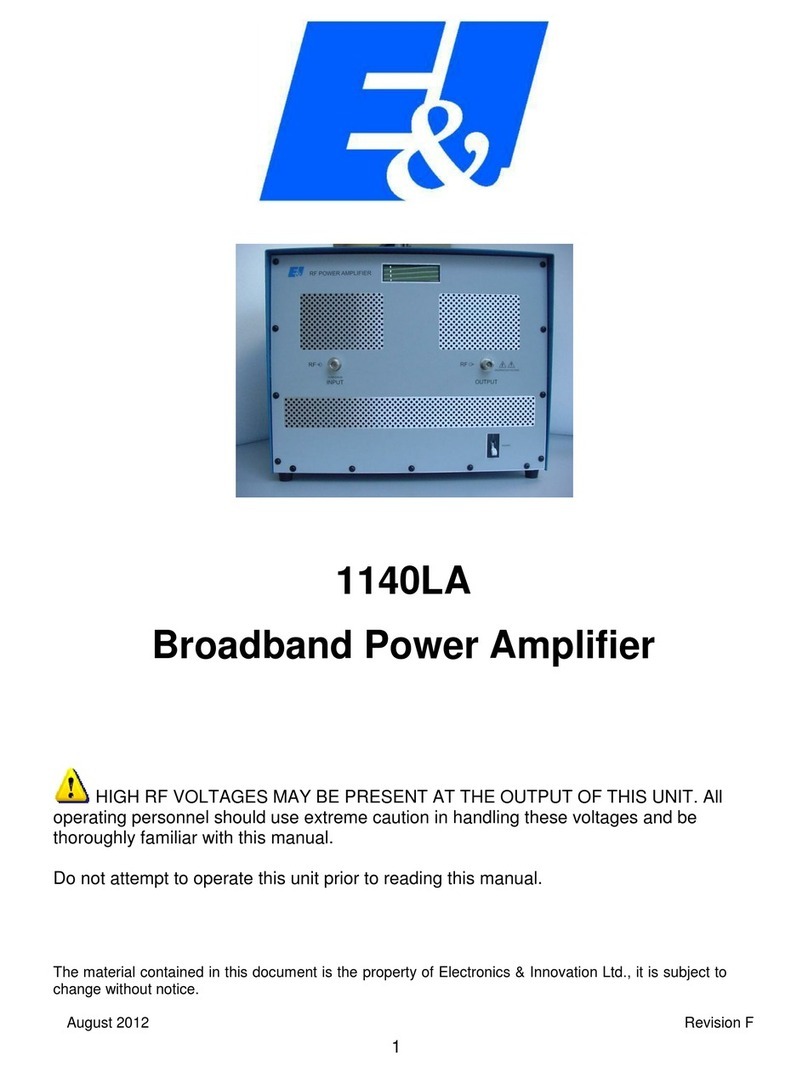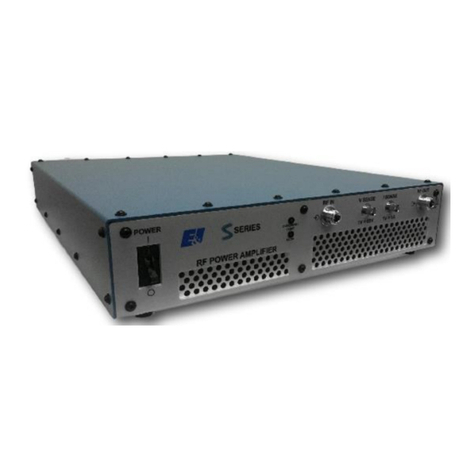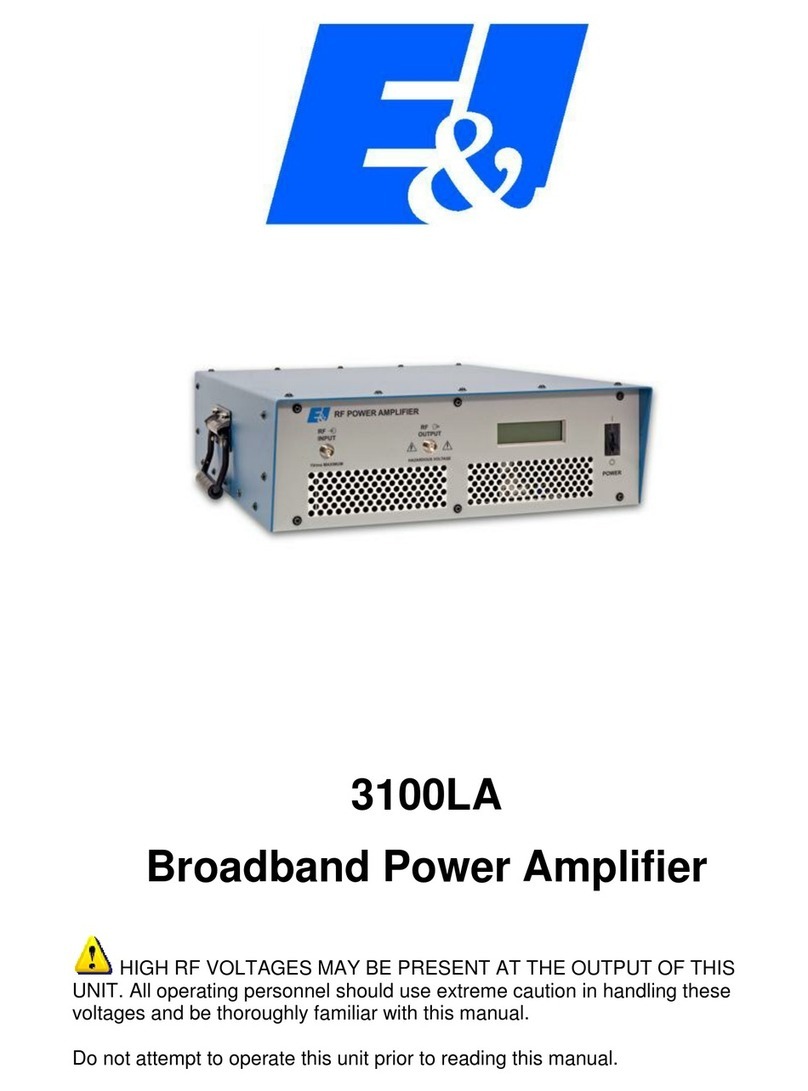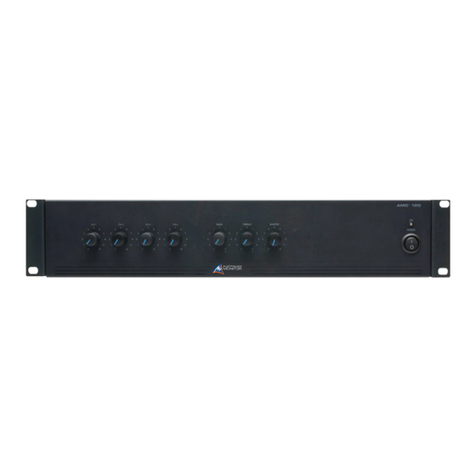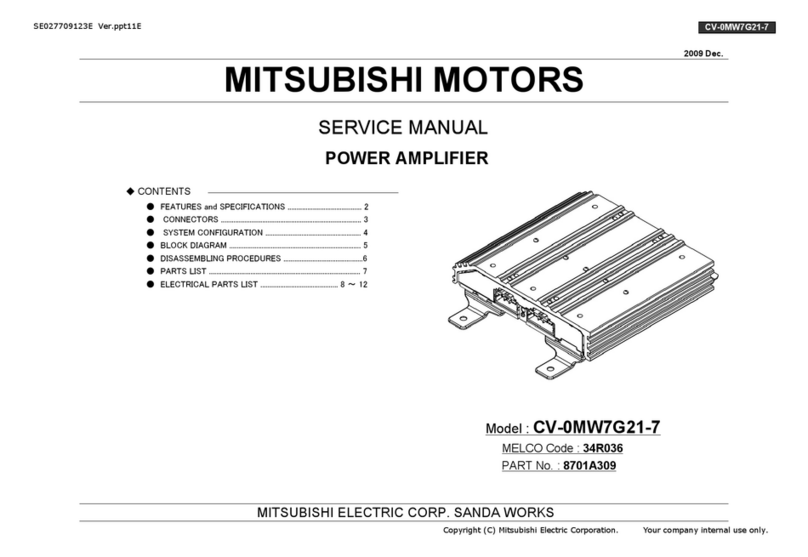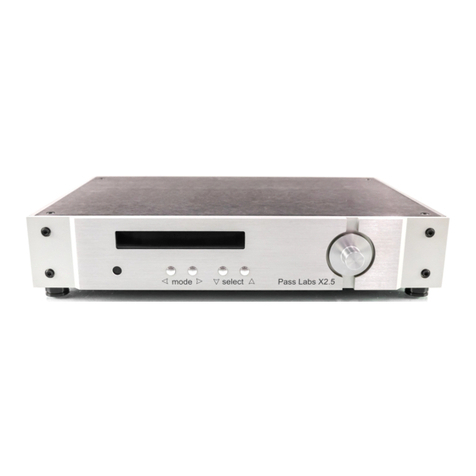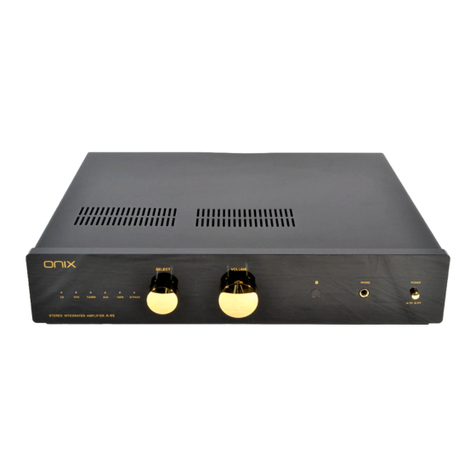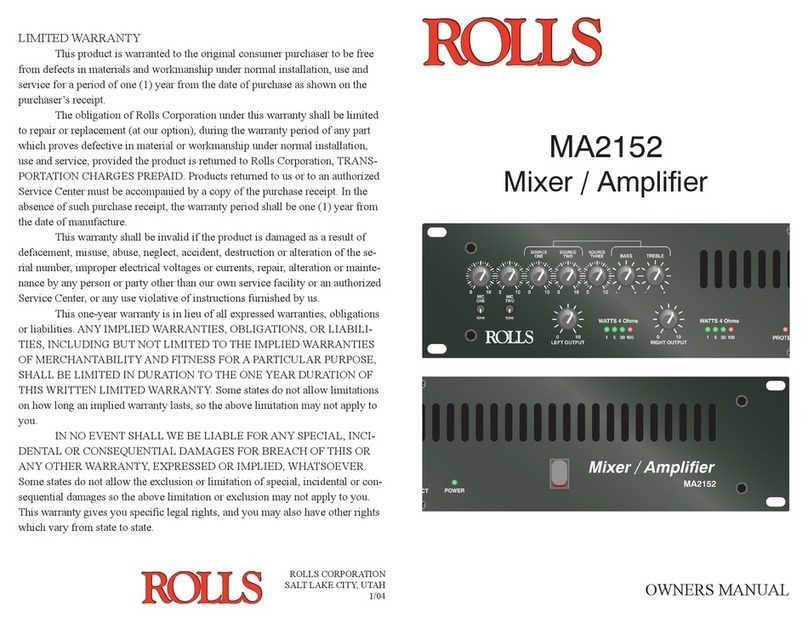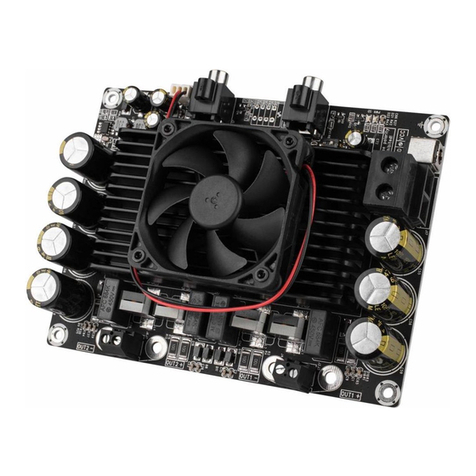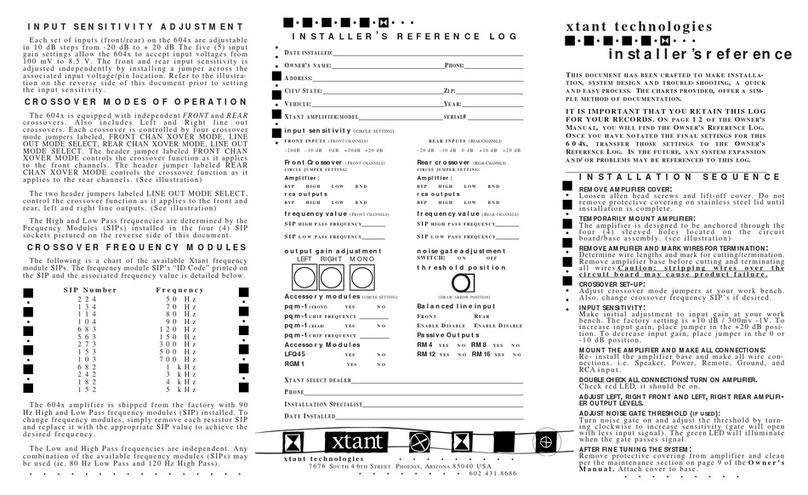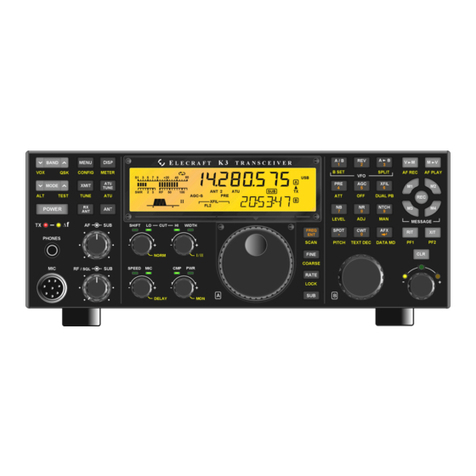E&I 210L User manual

The material contained in this document is the property of Electronics & Innovation Ltd., it is subject to
change without notice.
August 2013 Revision B
1
210L
Broadband Power Amplifier
HIGH RF VOLTAGES MAY BE PRESENT AT THE OUTPUT OF THIS UNIT. All
operating personnel should use extreme caution in handling these voltages and be
thoroughly familiar with this manual.
Do not attempt to operate this unit prior to reading this manual.

The material contained in this document is the property of Electronics & Innovation Ltd., it is subject to
change without notice.
August 2013 Revision B
2
Warranty
Electronics & Innovation Ltd., (hereafter E&I) warrants for the period of three year from
the date of original delivery, each unit to be free of defects in materials and workmanship.
For the period of 36 months E&I will, at its option, repair or replace defective parts so as
to render the unit fully operational such that it performs according to the original
specifications; free of charge to the original purchaser.
Should warranty service be required, the unit must be returned to E&I, freight cost to be
borne by the owner. If, in our opinion, the unit has been damaged by use outside the
limits prescribed in this manual or by accident, then the warranty shall not be honored. In
such a case E&I will provide an estimate for repair, assuming repair is possible and
provide a quote at standard service rates.
Contents
Chapter 1
General Information……………………………………………………………3
Chapter 2
Operation………………………………………………………………………..4
Chapter 3
Technical Information………………………………………………………….7
Chapter 4
Maintenance……………………………………………………………………8
Chapter 5
Safety……………………………………………………………………………12

The material contained in this document is the property of Electronics & Innovation Ltd., it is subject to
change without notice.
August 2013 Revision B
3
Chapter 1 Introduction
The 210L is a broadband solid state amplifier covering the frequency spectrum from 15
KHz to 12 MHz. It is rated at 10 watts of RF power with low harmonic and intermodulation
distortion. Over 10 watts of saturated power can be produced with increased distortion
products. A highly linear Class A design, the 210L will amplify inputs of AM, FM, SSB,
pulse and any complex modulation signals. The amplifier has 40 dB gain it is
unconditionally stable and will not oscillate even with combinations of mismatched source
and load impedance. It is protected against failure due to output load mismatch.
. An integral power supply permits operation from 115/230 single phase AC power.
1.2 INSTRUMENTATION IDENTIFICATION
Each amplifier is identified by a serial number tag on the back panel of the unit. Both the
model number and the serial number should be quoted to identify specific unit.
1.3 SPECIFICATIONS
Physical and electrical specifications are listed in Table 1-1 below

The material contained in this document is the property of Electronics & Innovation Ltd., it is
subject to change without notice.
August 2013 4 Revision B
Table 1-1. SPECIFICATIONS
FREQUENCY COVERAGE:
15 KHz to 12 MHz.
GAIN:
40 dB min, ±1.5 variation.
CLASS A LINEAR OUTPUT:
Nominal 10 watts.
HARMONIC DISTORTION:
> -25 dBc at 10 watts output.
INPUT IMPEDANCE
50 ohms, VSWR, 1.5:1 Maximum.
OUTPUT IMPEDANCE:
50 ohms, VSWR, 2.5:1 Maximum
STs STABILITY:
Continuous operation into any load or
source impedance.
PROTECTION:
Unit will withstand a + 13dBm input
signal (1.0 Volts RMS) for all output load
conditions, without damage.
POWER REQUIREMENTS:
100 –240 VAC 47-63 Hz.
SIZE:
13.5 X 12.0 X 3.25 inches 34.3 X 30.5 x
8.3 cm.
WEIGHT:
8.5 pounds 3.9 kg
CONNECTORS:
BNC
OPERATING TEMPERATURE:
0 –40 C
RACK MOUNTING:
Chapter 2 Operation
2.1 INTRODUCTION
The 210L RF amplifier is used to amplify the RF level of signal sources in the 15
KHz to 12 MHz range. No tuning or any other form of adjustment is required.
The 210L produces power output at its output connector, regardless of load
impedance. Any power reflected due to output load mismatch is absorbed in the
amplifier. Therefore, although the output impedance is 50 ohms (maximum
VSWR: 2.5:1), the amplifier will work into any load impedance.
2.2 RACK INSTALLATION
This unit is 2U high, 12” width. With it will fit into a standard rack.
2.2.1 Mains Voltage
The unit accommodates AC line voltages from 100 TO 240 VAC 47 –63 Hz

The material contained in this document is the property of Electronics & Innovation Ltd., it is
subject to change without notice.
August 2013 Revision B
5
2.3 OPERATION
A line cord is supplied to form a connection between the mains supply and the
rear of the unit. Plug this into AC input at the rear of the unit and the AC mains
outlet.
2.3.1 Proceed as follows:
(i) Ensure that there is at least 3” or 7.5 cm clearance at the rear of the
unit for air flow.
(ii) Switch on power and observe that the green led illuminates. (A brief
flash of the fault led is normal at turn on).
(iii) Ensure RF input voltage is not excessive
a. The 1 V rms indicated maximum input voltage is 5 times the level of
the input signal required to achieve maximum output. Input voltages
in excess of 2 volts peak may permanently damage the instrument.
(iv) Connect the output via a 50 ohm coaxial lead and BNC plug to the
load.
(v) Connect the input signal via a 50 ohm coaxial lead and BNC plug to
the input connector.
Chapter 3 Technical Description
3.1 GENERAL DESCRIPTION
The 210L is designed to amplify signals by 40 dB in the frequency band of 15
KHz to 12 MHz. The signal from the front panel BNC connector is fed via a length
of 50 ohm coaxial cable into the input of the two way splitter. The signal is split
into two and fed to the two power amplifiers that are in parallel with each other.
Each power amplifier is a two stage unit, each stage comprising of a push-pull
LDMOS Fet. The output of each stage is then combined and fed to the output of
the unit.
The power supply unit provides a 35.3 VDC 5 ampere source. It is a switch mode
power supply unit. The output feeds the PA The power supply also has a 5 VDC
output which feeds the fault detection board.

The material contained in this document is the property of Electronics & Innovation Ltd., it is
subject to change without notice.
August 2013 Revision B
6
If the PA heat sink temperature exceeds 70C the unit will fault to prevent
damage. This will be indicated by a Red LED on the front panel. The unit will not
need to be power cycled to reset the fault condition.

The material contained in this document is the property of Electronics & Innovation Ltd., it is
subject to change without notice.
August 2013 Revision B
7
Chapter 4 Maintenance
4.1 INTRODUCTION
The 210L RF amplifier requires no periodic maintenance. The instrument is
unconditionally stable and is fail-safe under all load conditions. Damage can only
be externally caused by the incorrect selection of the AC supply voltage or by an
input signal in excess of the specified 1 volt rms equivalent to a power level of
13dBm.
This chapter therefore, deals only with certain fundamental procedures for fault
location.
Performance limits quoted are for guidance only and should not be taken for
guaranteed performance specifications unless they are also quoted in the
Specification Section 1.2.
4.2 PERFORMANCE CHECKS
To determine the amplifier’s performance carry out the following procedure.
4.2.1 Initial Check
The following check can be made after repair and adjustments or
whenever the condition of the unit is in question.
a. Connect AC power supply. Switch on power and observe that the
green led illuminates. A brief flash of the fault led is normal at turn on.
b. Connect a sweep generator (HP 8601 or similar) capable of sweeping
the frequency range 15 KHz to 12 MHz, to the input connector.
c. Adjust the output level of the sweep generator so that a 50 ohm video
detector connected at the output of the unit will not be damaged by
excessive power output. (Reference section 4.4.1 for set up.)
d. Observe the gain versus frequency ripple on an oscilloscope calibrated
in decibels. The gain variation must be not more than +/- 1.5 dB over
the frequency range.
e. Connect a calorimetric power meter (HP434 or equivalent) through a
10 dB 200 watt attenuator to the output connector. Adjust the input CW
signal to any frequency between 15 kHz and 12 MHz for 10 watts
output.
f. Observe the harmonic distortion of the output on a spectrum analyzer.

The material contained in this document is the property of Electronics & Innovation Ltd., it is
subject to change without notice.
August 2013 Revision B
8
The harmonic components contributed by the amplifier should be
better than 25 dB down from the fundamental.
(a) If the above items are found to be outside of the specification, check
the spectral content of the input signal. If this is a pure signal then
the unit needs to be returned to the factory for service.
4.4.2 Measurement of Harmonics
Figure 4-2.
1.) Equipment Required:
a) Sweep/Signal Generator
b) Calorimetric Power Meter HP434A
c) Spectrum Analyzer.
d) Attenuator (20dB)
e) Attenuator (30dB)
f) Coupler (30 dB)
2.) Connect the Equipment as shown in Figure 4-2, then
proceed as follows:
a) Adjust the signal generator to a CW center frequency of 1 MHz, for an
indicated output of 10 watts on the power meter.
b) Using the spectrum analyzer, check that the level of the carrier
harmonics is less than -25 dB with respect to the carrier while manually
scanning the frequency band of 15 KHz to 12 MHz. An indicated power
output of 10W should be maintained during this operation.
30 dB
coupler

The material contained in this document is the property of Electronics & Innovation Ltd., it is
subject to change without notice.
August 2013 Revision B
9
4.5 PACKAGING FOR RESHIPMENT
In the event of the equipment being returned for servicing it should be packed in
the original shipping carton and packing material. If this is not available, wrap the
instrument in heavy paper or plastic and place in a rigid outer box of wood,
fiberboard or very strong corrugated cardboard. Use ample soft packing to
prevent movement. Provide additional support for projecting parts to relieve
these of unnecessary shock. Close the carton securely and seal with durable
tape. Mark the shipping container FRAGILE to ensure careful handling.
Chapter 5 Safety:
Do not attempt to operate this unit with the cover removed. High AC and DC
voltages are present. The cover prevents against electrical shock due to AC line
voltages, high DC and RF fields. Further the cover provides part of the cooling
system design. Components, specifically on the RF driver board are prone to
over-heat and eventual failure if the unit is operated without the cover in place.
Ensure that the load is connected to the output prior to connecting the RF input
to the unit. This will prevent high voltages being present and exposed at the
output connector.
Only use the AC cord provided or equivalent.
Ensure that the mains outlet is properly grounded.
Table of contents
Other E&I Amplifier manuals
Popular Amplifier manuals by other brands

Inter-m
Inter-m V-3000 Operation manual
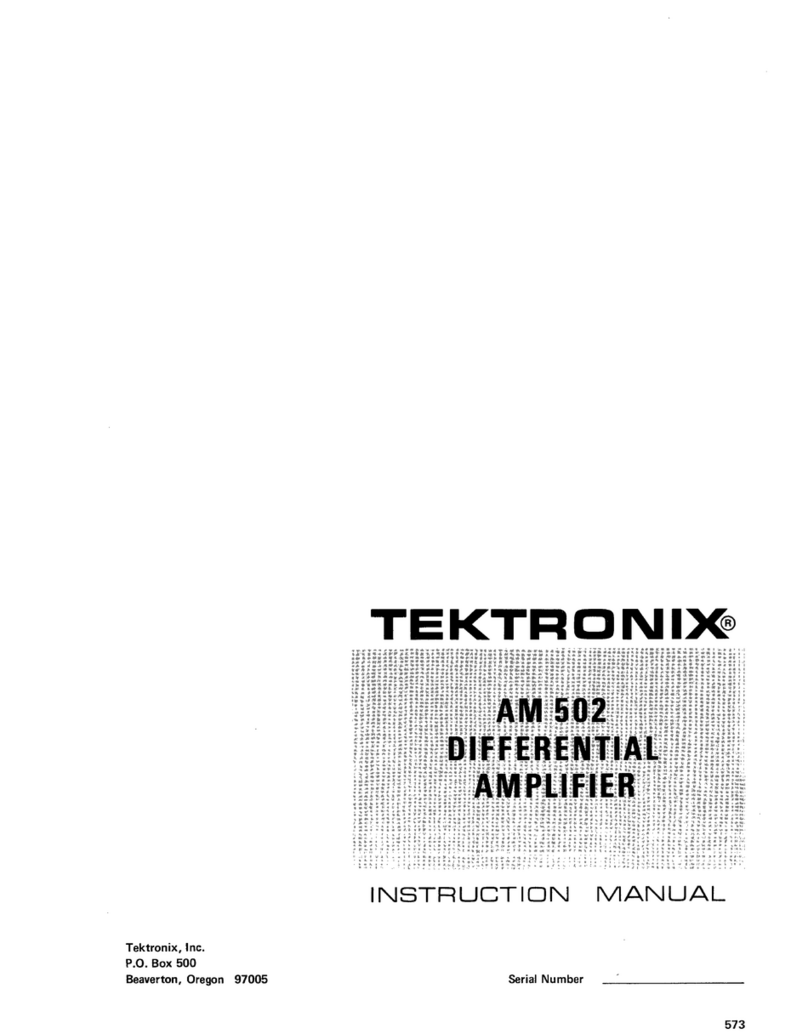
Tektronix
Tektronix AM 502 instruction manual
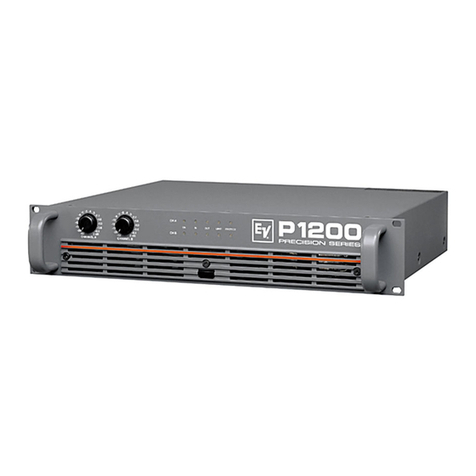
Electro-Voice
Electro-Voice Precision P 1200 Brochure & specs
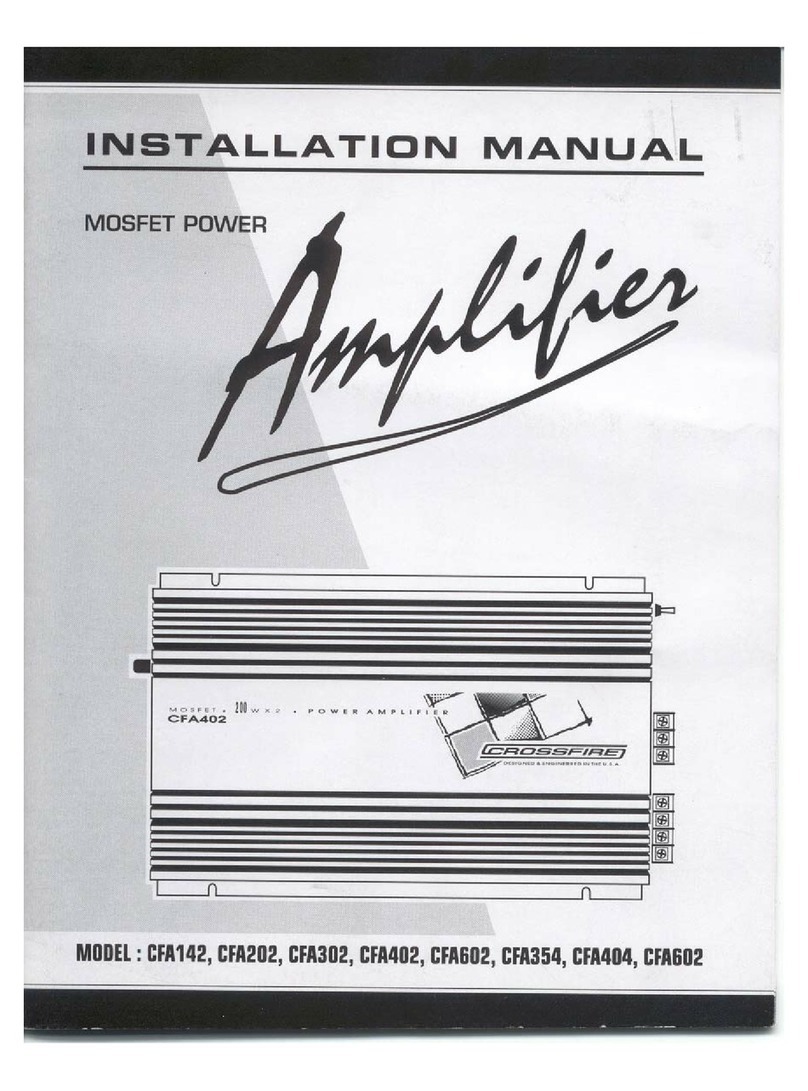
Mosfet Power
Mosfet Power Crossfire CFA142 installation manual

Bellman & Symfon
Bellman & Symfon Bellman Audio Mino BE2030 quick guide
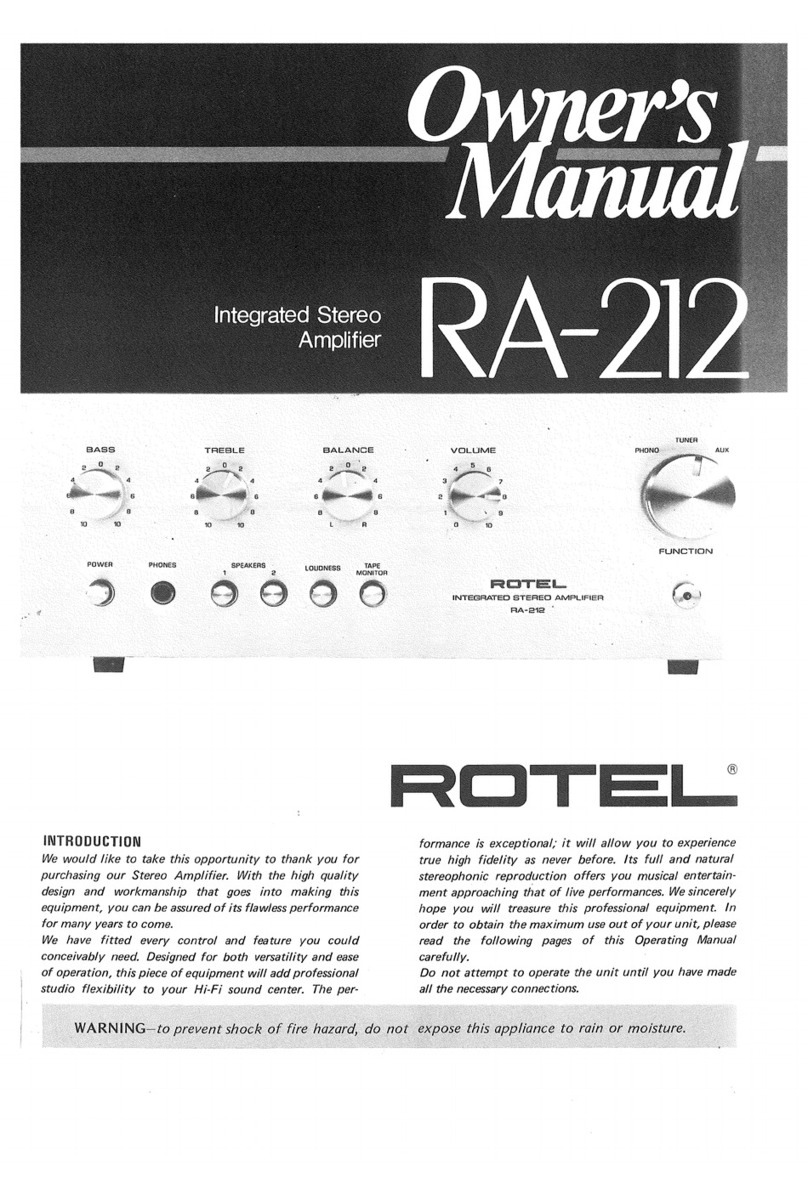
Rotel
Rotel RA-212 owner's manual
